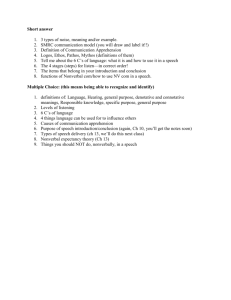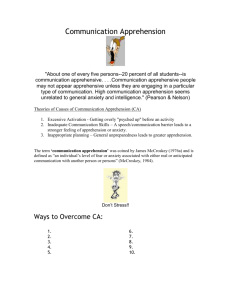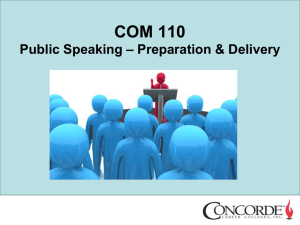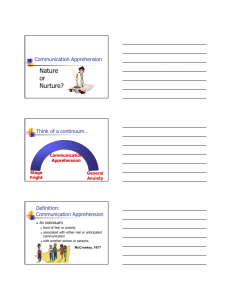Student's Strategies to Reduce Writing Apprehension (A Case Study on... Mediterranean Journal of Social Sciences Dr. Ibrahim Fathi Huwari (Corresponding author)
advertisement
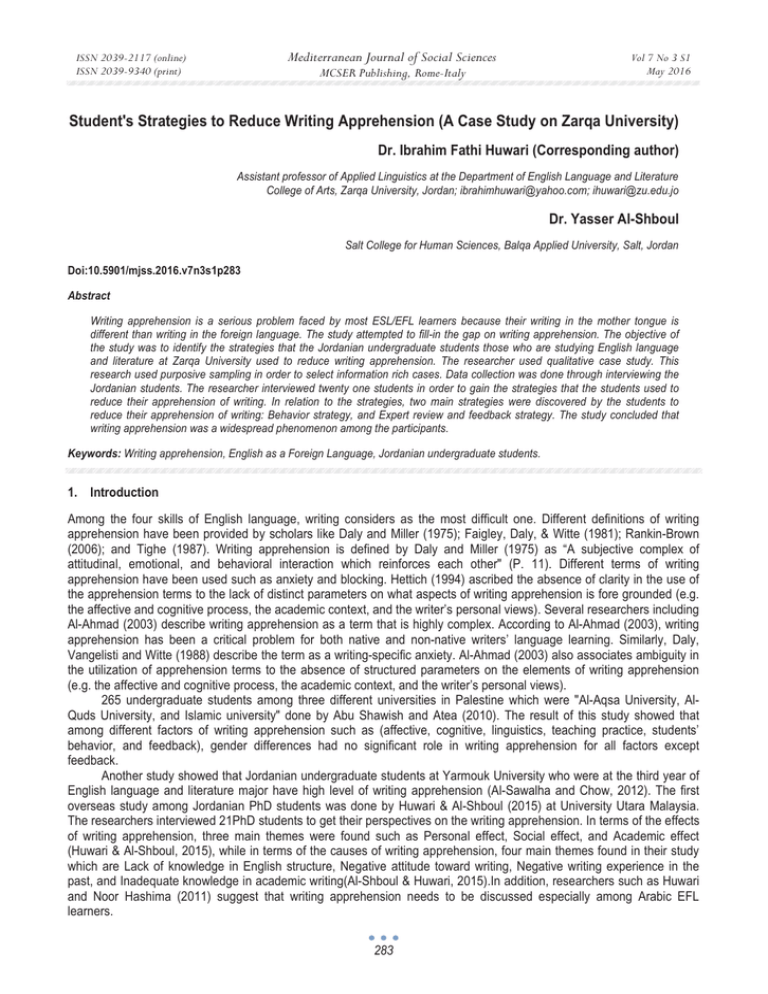
Mediterranean Journal of Social Sciences ISSN 2039-2117 (online) ISSN 2039-9340 (print) MCSER Publishing, Rome-Italy Vol 7 No 3 S1 May 2016 Student's Strategies to Reduce Writing Apprehension (A Case Study on Zarqa University) Dr. Ibrahim Fathi Huwari (Corresponding author) Assistant professor of Applied Linguistics at the Department of English Language and Literature College of Arts, Zarqa University, Jordan; ibrahimhuwari@yahoo.com; ihuwari@zu.edu.jo Dr. Yasser Al-Shboul Salt College for Human Sciences, Balqa Applied University, Salt, Jordan Doi:10.5901/mjss.2016.v7n3s1p283 Abstract Writing apprehension is a serious problem faced by most ESL/EFL learners because their writing in the mother tongue is different than writing in the foreign language. The study attempted to fill-in the gap on writing apprehension. The objective of the study was to identify the strategies that the Jordanian undergraduate students those who are studying English language and literature at Zarqa University used to reduce writing apprehension. The researcher used qualitative case study. This research used purposive sampling in order to select information rich cases. Data collection was done through interviewing the Jordanian students. The researcher interviewed twenty one students in order to gain the strategies that the students used to reduce their apprehension of writing. In relation to the strategies, two main strategies were discovered by the students to reduce their apprehension of writing: Behavior strategy, and Expert review and feedback strategy. The study concluded that writing apprehension was a widespread phenomenon among the participants. Keywords: Writing apprehension, English as a Foreign Language, Jordanian undergraduate students. 1. Introduction Among the four skills of English language, writing considers as the most difficult one. Different definitions of writing apprehension have been provided by scholars like Daly and Miller (1975); Faigley, Daly, & Witte (1981); Rankin-Brown (2006); and Tighe (1987). Writing apprehension is defined by Daly and Miller (1975) as “A subjective complex of attitudinal, emotional, and behavioral interaction which reinforces each other" (P. 11). Different terms of writing apprehension have been used such as anxiety and blocking. Hettich (1994) ascribed the absence of clarity in the use of the apprehension terms to the lack of distinct parameters on what aspects of writing apprehension is fore grounded (e.g. the affective and cognitive process, the academic context, and the writer’s personal views). Several researchers including Al-Ahmad (2003) describe writing apprehension as a term that is highly complex. According to Al-Ahmad (2003), writing apprehension has been a critical problem for both native and non-native writers’ language learning. Similarly, Daly, Vangelisti and Witte (1988) describe the term as a writing-specific anxiety. Al-Ahmad (2003) also associates ambiguity in the utilization of apprehension terms to the absence of structured parameters on the elements of writing apprehension (e.g. the affective and cognitive process, the academic context, and the writer’s personal views). 265 undergraduate students among three different universities in Palestine which were "Al-Aqsa University, AlQuds University, and Islamic university" done by Abu Shawish and Atea (2010). The result of this study showed that among different factors of writing apprehension such as (affective, cognitive, linguistics, teaching practice, students’ behavior, and feedback), gender differences had no significant role in writing apprehension for all factors except feedback. Another study showed that Jordanian undergraduate students at Yarmouk University who were at the third year of English language and literature major have high level of writing apprehension (Al-Sawalha and Chow, 2012). The first overseas study among Jordanian PhD students was done by Huwari & Al-Shboul (2015) at University Utara Malaysia. The researchers interviewed 21PhD students to get their perspectives on the writing apprehension. In terms of the effects of writing apprehension, three main themes were found such as Personal effect, Social effect, and Academic effect (Huwari & Al-Shboul, 2015), while in terms of the causes of writing apprehension, four main themes found in their study which are Lack of knowledge in English structure, Negative attitude toward writing, Negative writing experience in the past, and Inadequate knowledge in academic writing(Al-Shboul & Huwari, 2015).In addition, researchers such as Huwari and Noor Hashima (2011) suggest that writing apprehension needs to be discussed especially among Arabic EFL learners. 283 ISSN 2039-2117 (online) ISSN 2039-9340 (print) Mediterranean Journal of Social Sciences MCSER Publishing, Rome-Italy Vol 7 No 3 S1 May 2016 2. Literature Review 2.1 Methods to Reduce Writing Apprehension There are innumerable ways in which writing apprehension can be reduced in students. Stapa (1998) explains why researchers concentrate on reducing writing apprehension and mentions four distinct reasons of writing apprehension. First of all, a particular amount of apprehension or anxiety is imperative for writers to succeed in writing. However, some students display a higher than usual level of writing apprehension that may impact their writing in a negative way and display poor writer’s performance. Secondly, students display their necessity of developing writing skills for the purpose of garnering positive encouragement to motivate them. Thirdly, students generally feel apprehension in writing when teachers ask them to compose a text. Therefore, teachers notice this apprehension in students and they will modify their teaching instruction to lessen this writing apprehension. The instructors may focus on correcting grammar, punctuation and students. This is especially true with ESL/EFL learners. Midwestern University students experienced writing apprehension. This apprehension might impact their ability to write effectively. This study was done by Hanna (2010). It discovered that also students at Midwestern University in U.S.A. rarely attempted to reduce writing apprehension because they felt that the college was too late to reduce their writing apprehension. They were also not concerned about what their teachers had used to reduce their writing apprehension. The above methods were followed closely by the recommendation of new methods proposed by Reeves (1997) to help reduce students writing apprehension. These new methods are listed in the following: (1) Writing more, (2) Discourage appropriation of voice, (3) Listen to fearful writers, (4) Share your past writing experiences, (5) Find patterns in students’ errors, (6) Contextualize and customize, (7) Conference during drafting stages, (8) Collaborate with students for evaluation criteria, (9) Coach peers for effective response, (10) Validate intrapersonal communication: Self-Talk, (11) Be aware of possible gender differences, (12) Vary writing modes, (13) Monitor attitudes, (14) Introduce discourse communities, (15) Talk about writers you like, (16) Give and attend public readings, (17) Share writing. It has been reported that the reduction of writing apprehension among students is not solely the teacher’s responsibility as students have a role too in it (Clark, 2005). Students hailing from Chandler-Gilbert Community College claim that they have improved themselves at the end of the course through the employment of the following strategies: (1) students should be confidence of their writing; (2) Write a specific point for each step; (3) Having breaks once you feel unwell; (4) Asking for help; (5) Followed the process of writing; (6) Write an outline before starting writing; (7) Learn from others; (8) Create the right environment; (9) Write multiple drafts; (10) Try editing one’s paper; (11) Go over the instruction; (12) Try to complete the assignment before the last minutes of submission; (13) Think positively of the anxiety; (14) Brainstorm before start writing; (15) Do not panic right away; (16) Choose the suitable topic; (17) Understanding the instruction; (18) Clear mind; (19) Learn more about writing strategies; (20) Know and understand one’s limit; (21) Get to know other classmates better; (22) Prepare well; (23) Accept that it is ok to make mistakes. Students claimed that through the use of these strategies, on becoming anxious, they were more capable of reducing their anxiety or used it in a positive way as opposed to letting it get the better of their writing process. Daud, Daud and Kassim(2005) propose a few strategies that will enable the reduction of students’ writing apprehension: (1) Teachers should focus more on the way they taught, (2) Teachers encourage students to finish their writing tasks or help them in solving the problem given, (3) Teachers should use different strategies to improve students’ their vocabulary, (4) Teachers teach writing as a fluency rather than accuracy, (5) Teachers should ask students to correct the mistakes on their own. Abu Shawish and Atea (2010) provide a summary on the measures used on writing apprehension which exist in the literature on second/foreign language: 1. Teachers should give students writing assignment which is not graded because of the students’ fear of being negatively evaluated (Clark, 2005). 2. Feedback should be given in a good way (Borich, 2004; Clark, 2005; Grabe and Kaplan 1995; Kurk and Atay, 2007). 3. Writing should be teaching as a process (Clark, 2005; Grabe& Kaplan, 1995, Rankin-Brown, 2006). 4. Students should correct their mistakes (Bernstein, 1978; Reeves, 1997; Wachholz& Etheridge, 1996). 5. Having enough time on free writing activities (Boice, 1993; Dickson-Markman, 2001; Stover, 1988; Veit, 1980). 6. Teaching writing concurrently to reduce writing apprehension (Daud et al., 2005). In sum, the researchers of the present study has illuminated the most common ways of reduce writing apprehension. Researchers have displayed a consensus in the utilization of some ways that are critical to the reduction of 284 ISSN 2039-2117 (online) ISSN 2039-9340 (print) Mediterranean Journal of Social Sciences MCSER Publishing, Rome-Italy Vol 7 No 3 S1 May 2016 writing apprehension such as collaborative and centered-oriented approaches. It has been found that through literature; only a few studies have been conducted to find ways to reduce writing apprehension through the student’s perspectives. Majority of the studies conducted in reducing writing apprehension have been carried out through teachers’ perspective and experience such as by Al Ahmad (2003); Clark (2005); and Daud et al. (2005). A few studies have been conducted on the strategies that students use to reduce writing apprehension. 3. Research Objective In order to understand writing apprehension phenomenon, the following research objective guided this study: This study aims to identify the strategies that the undergraduate students those are majoring in English Language and Literature in Zarqa University (ZU) used to reduce their writing apprehension. 4. Significance of the Study Limited numbers of studies have been conducted on Jordanian students who are studying English Language at the bachelor level. In addition, most of the studies were done among native speaking countries; therefore, this research is done among EFL learners. The researcher will guide other researchers of understand the strategies of writing apprehension. Identifying the strategies of writing apprehension would enhance our understanding of the writing apprehension among Arab students. In addition, this study will add to the literature the students’ perspective of writing apprehension as most of the research focused on teachers' perspective of writing apprehension. 5. Methodology 5.1 Research Design A qualitative case study is used in this study to enable the researchers to understand the writing apprehension phenomenon as described and experienced by the participants when writing in English. Creswell (2012, p.46) defines a qualitative research as “a type of educational research in which the researcher relies on the views of participants, asks broad, general questions, collects data consisting largely of words (or text) from participants, describes and analyzes these words for themes, and conducts the inquiry in a subjective, biased manner”. The researchers in this study selected the qualitative case study design to answer the research question because it is the most suitable research design to answer the research question. Merriam defines case study as “an intensive, holistic description and analysis of a single instance, phenomenon, or social unit” (1998, p.27). In addition to the above reasons, the researcher decided to use qualitative research methodology because of the following reasons. First, the multiple views of reality are acceptable in qualitative tradition. Different people have different views about a phenomenon such as writing apprehension. This study focused on WA from undergraduate students' views at ZU. Second, qualitative research tries to gain insight from the emic, or insider’s perspectives instead of the etic, or outside’s perspectives of the phenomenon (Merriam, 1998). This study focused on the strategies of writing apprehension experience of Jordanian students. Third, in qualitative research the researcher is the primary instrument for data collection and analysis. Lastly, qualitative research “study things in their natural settings, attempting to make sense of, or interpret, phenomena in terms of the meanings people bring to them” (Denzin and Lincoln, 1994, p.2). This study focused on Jordanian undergraduate students' at ZU those who are majoring in English language and literature experience in relation to writing apprehension in ZU. 5.2 Participants The participants of this study consisted of Jordanian undergraduate students' at ZU those who are majoring in English language and literature. Creswell (2008) states that the number of people and sites sampled are different from one qualitative study to the next one. In this study, the number of participants to be interviewed depended on data saturation. The researchers adopted purposeful sampling which refers to “those cases from which one learn a great deal about issues of central importance to the purpose of the research” (Patton, 1990, p.169). Homogeneous sampling used in this study which means that “the researcher purposefully samples individuals or sites based on membership in a subgroup that has defining characteristics” (Creswell, 2012, p. 208). The researchers had to identify the characteristics of the participants. 285 ISSN 2039-2117 (online) ISSN 2039-9340 (print) 5.3 Mediterranean Journal of Social Sciences Vol 7 No 3 S1 May 2016 MCSER Publishing, Rome-Italy Data Collection In qualitative research, the researchers are the primary instrument for gathering and analyzing the data. This study used interviews to uncover and describe the participants’ perspectives on events, that is, the subjective view was the focus (Marshall and Rossman, 1995). In this study, the researchers themselves conducted the interview. Semi-structured interview used to collect the data. During the interview, the researchers gave some attention to the conversation with the participants. 6. Results and Discussion The research question: what are the strategies that the undergraduate students those are majoring in English language and literature at ZU use to reduce the apprehension in writing? To obtain the strategies that students used, an understanding of a tactic is needed. In this study, a tactic is defined as a conscious and immediate response made by a participant to deal with writing apprehension experience when writing in English. After getting the responses from the participants, the strategies were classified based on their similarities. Four strategies were emerged in this study. Table 1 displays the strategies that used by the participants in this study. The researchers categorized these four strategies into two main themes. The first main theme is behavior strategy which included preparation, technology programs, and peer seeking. The second main theme is expert review and feedback strategy which included only one sub-theme: guidance from lecturers. Table 1 displays the occurrences which denote how many times the participants mentioned the strategy that they used to reduce apprehension in writing. Table 1: Strategies to Reduce Writing Apprehension Theme Behavior Strategy Expert Review and Feedback Strategy 6.1 Sub-Theme *Preparation *Using Technology Programs *Peer Seeking *Guidance from Lecturers Occurrence 19 11 10 16 Behavior strategy Behavior strategy was the most commonly used strategy by all the participants in this study to reduce writing apprehension when writing their writing in English. This theme was divided into three sub-strategies used by the participants. 6.1.1 Preparation Preparation in this study was used as a strategy to reduce students’ writing apprehension. Almost all of the participants (19 out of 21) mentioned that they used the preparation strategy in the process of writing in order to reduce writing apprehension. This sub-theme "preparation" included reading more whether reading articles, or books, writing more whether writing assignments, rewrites their works, and attending courses. The participants admitted that reading is a very important step to improve their writing in English. Participants such as 1, 8, and 15 believed that reading a lot is an important strategy to reduce apprehension in writing. Participant 4 gave a lengthy explanation on how he tried to improve his writing skill and reduce writing apprehension. He said: I always read other works especially articles to improve my writing. I was looked on how the authors can summarize the long sentences in a few words only. Participant 14 mentioned that reading academic books helped him to improve his writing and he avoided the grammatical mistakes that he always did before. He commented: Using the English grammar books especially the TOFEL educational books that includes many rules and grammars. Furthermore, about half of the participants (11 out of 21) stated that keeping writing is a very important strategy to reduce writing apprehension whether rewriting their work, writing papers for journals or conferences and extra writing. 286 ISSN 2039-2117 (online) ISSN 2039-9340 (print) Mediterranean Journal of Social Sciences MCSER Publishing, Rome-Italy Vol 7 No 3 S1 May 2016 Participants 3, 5 and 10 claimed that they tried to improve their writing by rewriting their original work a few times until they were satisfy with their work as well as their supervisors. By adopting this strategy, they believed that the apprehension in writing would be decreased. They said that “I rewrite my work many times to get what I want. So, my apprehension is decreased”. Participant 11 had the same opinion as the other participants by claiming that writing more was the best way to reduce apprehension in writing and improve writing skill. He said: I was doing a practice until I improve my writing because writing needs a lot of vocabulary to use and grammars. So, I was write more until I improve my writing. 6.1.2 Using Technology Programs The second sub-strategy was using technology programs to reduce writing apprehension. This sub-strategy emerged from the main theme which was behavior strategy. Using technology programs means that participants try to improve their writing by using some technology programs such as Google translation, dictionaries and internet websites to improve their writing and reduce writing apprehension.(11 out of 21)participants claimed that they used technology programs when writing in English. Participant 3 commented that he used on-line dictionaries to find the meaning of ambiguous vocabularies whether from Arabic to English or from English to Arabic. He said: Using internet or Google to help me to translate the difficult meaning. I use some programmers such as ϲϓϮϟ. At the same time, participant 14 commented that he used Google translator to overcome writing apprehension. He said: I use Google and Google translator to understand the correct meaning of the words. I translated the single words from English to Arabic only. Also, I use the dictionary provided by the Microsoft words which give you the synonyms and antonyms of the words and the correct usage for the words. I also use the dictionary especially the oxford dictionary for identifying the correct meaning for certain words. Participants 4, 5, 7, and 16 had the same view with the other participants by claiming that they used dictionaries and on-line programmes to reduce their apprehension in writing. Participant 4 said: "I used Google translation to translate paragraphs from Arabic to English or from English to Arabic to understand the meaning". 6.1.3 Peer Seeking Another behavior strategy that was commonly used by the participants is peer seeking. In this study, about half of the participants (10 out of 21) mentioned that peer seeking was a strategy that they used to reduce writing apprehension. This means that getting support or consulting peers or colleagues feedback in order to cope with writing apprehension. Participant 7 thought that he would never write in a perfect way. He believed other people could help him write perfectly. He said: Sometimes, I feel it is difficult for me to write exactly perfect should to ask somebody to help me. Participant 4 commented that he showed his writing to those he trusted. He said: Sometimes I showed my work to close friends only because I can get a feedback from them because I trust on them. I didn’t show my works to others because I don’t trust others. I don’t like to get a feedback from someone that I don’t know. Participant 5 stated that he asked his friends to teach him how to rewrite his works. He said: I asked my friends to teach me how to rewrite the sentences. Participant 9 shared his experience of writing with his colleagues in order to get feedback from the supervisor. He said: 287 ISSN 2039-2117 (online) ISSN 2039-9340 (print) Mediterranean Journal of Social Sciences MCSER Publishing, Rome-Italy Vol 7 No 3 S1 May 2016 I have shared my work with my colleagues and PhD students and my supervisor to get a feedback. 6.2 Expert Review and Feedback Strategy The second type of coping strategy derived from this study was expert review and feedback strategy. Most of the participants (17 out of 21) mentioned that expert review and feedback strategy was a very important strategy to reduce writing apprehension. Only one strategy which emerged from the participants’ responses in this study was guidance from the lecturers. The participants admitted that they received constructive feedbacks from their lecturers which decreased the level of their writing apprehension. Participants 3 and 16 admitted that their lecturers play a major role in solving the problems that they faced when writing in English. In addition, participant 14 also believed that his lecturer comments were very useful tool to decrease the apprehension in writing. He commented: My lecturer comments were very useful tool for enhancing and improving my ability in writing in English and in over to overcome those challenges in writing. Participant 21 also believed that his lecturer was very helpful. He said: I learn a lot from my lecturer because he graduated from an English speaking country. He has good pronunciation, good interaction. There was a good co-operation between me and him. Other participants such as 2, 7, 8, 9, 10, 11, 13, 15, 17, 18 and 19 believed that supervisors could help their students to improve their writing and to produce a high quality piece of papers. All the participants admitted that they followed their lecturers' advices to improve their writing. The findings of this question show that the Jordanian PhD students used four main strategies to reduce writing apprehension when writing their proposals in English which are behavior strategy, and expert review and feedback strategy. These two main strategies are divided into: Behavior strategy consists of (1) preparation (2) using technology programming such as Google translator, internet websites, and dictionaries, (3) peer seeking. Expert review and feedback strategy consists of 1 sub-strategy: guidance from their lecturers. Most of the studies on writing apprehensions such as by Al-Ahmad (2003); Boice (1993); Hanna (2010); and Tighe (1987) show teachers have different ways to reduce students writing apprehension. Different strategies are used depending on culture, and level of apprehension. From the postgraduate students’ perspective at King Saud University, Saudi Arabia, they used a few strategies to reduce their difficulties in writing such as use the process of writing, Writing an outline before writing a draft, and Reviewing what they have written before submission (Al Fadda, 2012).The strategies that the Jordanian students used to reduce their apprehension when they write in English are quite different from other students overseas. Reeves’s (1997) study mentioned 17 strategies that the students used. Out of the 17 strategies that the students used to reduce writing apprehension, only three strategies are similar to the present study: writing more, published papers, comments from other students and teachers. 23 strategies found in a study done by Clark (2005) to reduce their writing apprehension. Only 4 strategies are similar to this study: developing confidence in their writing ability or motivating, taking breaks, getting help and feedback, and try editing one’s paper. However, the present study mentioned 17 strategies that the Jordanian PhD students used to reduce their writing apprehension. A study done by Mo (2012) among Chinese students suggested three strategies that the students should use to reduce writing difficulties which are motivation, integrating reading with writing, and get feedback from the teachers. 7. Conclusion This research begins with a brief summary of this study followed by the strategies of writing apprehension, the methodology that has been used, the results of the study and lastly the conclusion of this study. The purpose of this study was to identify the strategies that the students used to reduce writing apprehension. A qualitative case study used in this study. In addition, 21 Jordanian undergraduate students those who are majoring in English language and literature at ZU were interviewed. The researcher used purposive sampling while the researchers selected homogeneous sampling strategy. Face to face interview was done to collect the data. The research question focused on the strategies that students use to reduce the apprehension of writing. The findings of this question showed that the Jordanian undergraduate students used two main strategies to reduce writing apprehension: behavior strategy, and expert review and feedback strategy. 288 ISSN 2039-2117 (online) ISSN 2039-9340 (print) Mediterranean Journal of Social Sciences MCSER Publishing, Rome-Italy Vol 7 No 3 S1 May 2016 References Abu Shawish, J., &Atea, M. (2010, October). An investigation of Palestinian EFL majors' writing apprehension: causes and remedies. In Proceedings of the First National Conference on improving TEFL methods & practices at Palestinian Universities. Retrieved from http://www.eric.ed.gov.eserv.uum.edu.my/PDFS/ED512894.pdf Al-Ahmad, S. (2003). The impact of collaborative learning on L1 and L2 college students' apprehension about and attitudes toward writing (Unpublished doctoral dissertation).Indiana University of Pennsylvania, United States. Al Fadda, H. (2012). Difficulties in academic writing: From the perspective of king Saud university postgraduate students. English Language Teaching, 5(3), 123-130. doi:10.5539/elt.v5n3p123 Al-Sawalha, A., M., S. & Chow, T., V., V. (2012). The effects of writing apprehension in English on the writing process of Jordanian EFL students at Yarmouk University. International Interdisciplinary Journal of Education, 1(1), 6-14. Retrieved from http://www.iijoe. org/IIJE_02_v1_i1_2012.pdf Al-Shboul, Y., &Huwari, I., F. (2015). The Causes of Writing Apprehension throughStudents’ Perspective.Journal of Language Teaching and Research, 6,(3), 535-544.DOI: http://dx.doi.org/10.17507/jltr.0603.08 Bernstein, A. (1979). Errors and expectations: A guide for the teacher of basic writing by Mina P. Shaughnessy. The School Review, 86(2), 292-294. Retrieved from http://www.citeulike.org/group/6270/article/3125009 Boice, R. (1993). Writing blocks and tacit knowledge.The Journal of Higher Education, 64(1), 19-54.Retrieved from http://www.jstor.org/ stable/2959976 Borich, G. D. (2004). Effective teaching method (5th ed.). New Jersey: Merrill. Clark, D. (2005, May). Explorations into writing anxiety: Helping students overcome their fears and focus on learning. Paper presented at the ISSOTL conference, Canada. Creswell, J. W. (2008). Educational research: Planning, conducting, and evaluating quantitative and qualitative research (3rd ed.). New Jersey: Pearson Education. Creswell, J. W. (2012). Educational research: Planning, conducting, and evaluating quantitative and qualitative research (4thed.).Boston: Pearson Education. Daly, J., Vangelisti, A., & Witte, S. (1988). Writing apprehension in the classroom context.The social construction of written communication, 7(3), 147-171. Daly, J. A., & Miller, M. D. (1975).Apprehension of writing as a predictor of message intensity.The Journal of Psychology, 89(2), 175177.doi: 10.1080/00223980.1975.9915748 Daud, N. M., Daud, N. M., &Kassim, N. L. A. (2005). Second Language Writing Anxiety: Cause or Effect? .Malaysian Journal of ELT, 1(1),1-19. Retrieved fromhttp://www.melta.org.my/Doc/second_lang_writing_anxiety.pdf Dickson-Markman, F. (2001). Free writing prompts and feedback. The Internet TESL Journal, 7(8), 9-19. Retrieved from http://iteslj.org/ Techniques/Dickson-Freewriting.html Faigley, L., Daly, J. A., & Witte, S. P. (1981).The role of writing apprehension in writing performance and competence.The Journal of Educational Research, 75(1), 16-21.Retrieved from http://www.jstor.org/stable/27539858 Grabe, W., & Kaplan, R. B. (1995).Theory and practice of writing. New York: Longman. Hanna, K. J. (2010). Student perceptions of teacher comments: Relationships between specific aspects of teacher comments and writing apprehension (doctoral dissertation, University of North Dakota). Retrieved from http://proquest.umi.com.eserv.uum.edu.my/ pqdweb?index=0&did=1949552481&SrchMode=1&sid=3&Fmt=6&VInst=PROD&VType=PQD&RQT=309&VName=PQD&TS=13 40782765&clientId=28929 Hettich, E., L. (1994). Writing Apprehension: A critique (doctoral dissertation, Purde University). Retrieved from: http://docs.lib.purdue. edu/dissertations/AAI9523364/ Huwari, I., F. & Al-Shboul.(2015). The Effects of Writing Apprehension among Jordanian PhD Students' Perspectives.Journal of Global Research in Education and SocialScience. International Knowledge Press,3(1), 22-32. Huwari, I &Hashima, N. (2011).Writing apprehension in English among Jordanian postgraduate students in UUM.Academic Research International Journal, 1(2), 190-198. Retrieved from http://www.savap.org.pk/journals/ARInt./Vol.1%282%29/2011%281.216%29.pdf Kurk, G., &Atay, D. (2007).Students' writing apprehension.Journal of Theory and Practice in Education, 3(1), 12-23. Marshall, C., &Rossman, G. B. (1995).Designing qualitative research. Thousand Oaks: Sage Publications. Merriam, S. B. (1998). Qualitative research and case study applications in education. San Francisco: Jossey-Bass Publishers. Patton, M. Q. (1990). Qualitative evaluation and research methods. Newbury Park, CA: Sage Publications. Rankin-Brown, M. (2006).Addressing writing apprehension in adult English language learners. In proceedings of the CATESOL state conference, Pacific Union College, United States. Reeves, L. V. L. (1997).Minimizing writing apprehension in the learner-centered classroom.The English Journal, 86(6), 38-45. Retrieved fromhttp://www.jstor.org/stable/820367 Stapa, S. (1998).The process approach to ESL writing.Bangi, Selangor: Faculty of Language Stuides, UniversitiKebangsaan Malaysia, Malaysia. Stover, K. (1988). Riposte: In defense of freewriting. English Journal, 77(2), 61-62.Retrieved fromhttp://eric.ed.gov/ERICWebPortal/ search/detailmini.jsp?_nfpb=true&_&ERICExtSearch_SearchValue_0=EJ373355&ERICExtSearch_SearchType_0=no&accno=E J373355 289 ISSN 2039-2117 (online) ISSN 2039-9340 (print) Mediterranean Journal of Social Sciences MCSER Publishing, Rome-Italy Vol 7 No 3 S1 May 2016 Tighe, M. A. (1987, March). Reducing writing apprehension in English classes. Paper presented at the Annual Meeting of the National Council of Teachers of English Spring Conference, Louisville, United States. Veit, R. (1980, November). Reducing anxiety in writing instruction.Paper presented at the Annual Meeting of the National Council of Teachers of English, Cincinnati. United States. Wachholz, P. B., & Etheridge, C. P. (1996).Writing self-efficacy beliefs of high-and low-apprehensive writers.Journal of Developmental Education, 19(3), 16-18. doi: 10.1080/10573560308222 290
